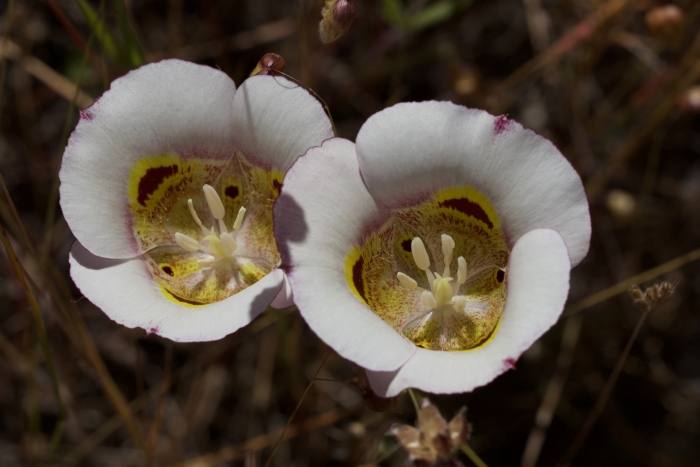Superb Mariposa Lily
(Calochortus superbus)
Superb Mariposa Lily (Calochortus superbus)
/
/

Arvel Hernandez
CC BY 4.0
Image By:
Arvel Hernandez
Recorded By:
Copyright:
CC BY 4.0
Copyright Notice:
Photo by: Arvel Hernandez | License Type: CC BY 4.0 | License URL: http://creativecommons.org/licenses/by/4.0/ | Rights Holder: Arvel Hernandez | Publisher: iNaturalist | Date Created: 2022-05-25T09:29:14-07:00 |

























Estimated Native Range
Summary
Calochortus superbus, commonly known as superb mariposa lily, is a perennial herb endemic to California, where it thrives in a variety of habitats including grasslands, open woodlands, and chaparral. It is particularly prevalent in the Coast Ranges and Sierra Nevada foothills. This species typically grows 16 to 24 inches tall and features a single basal leaf that can reach up to 12 inches in length. The inflorescence consists of a loose cluster of 1 to 3 bell-shaped flowers, each with three sepals and three petals that are often white to lavender with a distinctive yellow blotch at the bases. The flowering season is from late spring to early summer, and the flowers are quite showy, attracting pollinators such as bees and butterflies. The fruit is an angled capsule, measuring 2 to 3 inches long.
Superb mariposa lily is valued for its ornamental qualities, particularly its attractive and distinctive flowers. It is used in wildflower gardens, native plant landscapes, and as a border plant. In cultivation, it requires well-drained soils and full sun to part shade conditions. While it is drought-tolerant once established, it benefits from occasional watering during prolonged dry periods. It is relatively low maintenance but can be susceptible to bulb rot if overwatered or planted in poorly drained soils. There are no significant disease issues, but gardeners should be cautious of overwatering.CC BY-SA 4.0
Superb mariposa lily is valued for its ornamental qualities, particularly its attractive and distinctive flowers. It is used in wildflower gardens, native plant landscapes, and as a border plant. In cultivation, it requires well-drained soils and full sun to part shade conditions. While it is drought-tolerant once established, it benefits from occasional watering during prolonged dry periods. It is relatively low maintenance but can be susceptible to bulb rot if overwatered or planted in poorly drained soils. There are no significant disease issues, but gardeners should be cautious of overwatering.CC BY-SA 4.0
Plant Description
- Plant Type: Herb, Bulb
- Height: 1.5-2 feet
- Width: 0.25-0.6 feet
- Growth Rate: Moderate
- Flower Color: Yellow
- Flowering Season: Spring, Summer
- Leaf Retention: Deciduous
Growth Requirements
- Sun: Full Sun, Part Shade
- Water: Low
- Drainage: Medium
Common Uses
Butterfly Garden, Deer Resistant, Drought Tolerant, Low Maintenance, Rock Garden
Natural Habitat
Native to grasslands, open woodlands, and chaparral in California, especially in the Coast Ranges and Sierra Nevada foothills
Other Names
Common Names: Superb Mariposa Lily, White Mariposa Lily
Scientific Names: , Calochortus superbus, Calochortus luteus var. citrinus, Calochortus luteus var. robustus, Calochortus pratensis, Calochortus superbus, Calochortus superbus var. pratensis, Calochortus superbus var. pratensis, Calochortus venustus var. citrinus, Calochortus venustus var. lilacinus
GBIF Accepted Name: